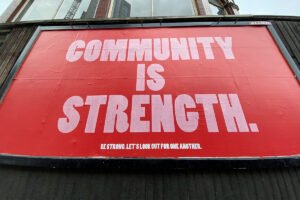
Despite reporting high levels of mental illness, US Latinx community members often fail to receive adequate care.
The 2022 National Survey on Drug Use and Health showed that just over a fifth of Hispanic adults (21.4 percent) reported having a mental illness—defined in the report as a diagnosed mental, emotional, or behavioral disorder that may have interfered with their lives. That’s less than the rate of White Americans (24.6 percent) but more than that of Black Americans (19.7 percent) and Asian Americans (16.8 percent).
This gap is fueled by a series of barriers that include linguistic limitations, higher poverty rates, lack of insurance, the high cost of treatment, the lack of bilingual services, and the lack of training of many mental health professionals to understand Latin American cultures that often discourage accessing mental healthcare. Overcoming this stigma remains a central challenge.
Community Connections
SOMOS Community Care—a network of healthcare providers in the Bronx, Queens, Manhattan, and Brooklyn who have come together to serve Medicaid patients in New York City—began conducting mental health screenings for all patients. It doesn’t matter the reason for the appointment, says Riquelmy Lamour, director of behavioral health and social work at SOMOS.
“It is impressive that in 2024, we are still dealing with stigma. We still use words like ‘crazy’…‘a screw is missing.’ This language is problematic. We see in the Latino community specifically mental health as something shameful, particularly in traditional families,” Lamour tells NPQ.
Lamour also notes that there are several community-based approaches that can be effective in overcoming this stigma. First, the role of family doctors can be critical: A patient is more likely to approach a mental health professional if they are referred by their trusted doctor.
“There are not a lot of therapists who take the insurance.…You have to go through all these hoops to get the money, while reimbursement rates are low.”
Another important intermediary is faith-based organizations. Often, if children are using drugs or there are other family problems, many Latinx community members approach their churches before seeking mental health support. At faith-based organizations, priests often play a vital connecting role by recommending that a parishioner visit a psychiatrist or a therapist. There is a bond of trust between the priest and community members that can overcome stigma and lead more community members to follow through on referrals and visit a mental health professional.
Insurance Access
Lack of access to health insurance is another factor limiting access to mental health services. According to a June 2024 federal report, “Latinos are more than twice as likely as non-Latino Whites to be uninsured.”
US Census Bureau data indicate that the nation’s Latinx residents comprise 19 percent of the country’s total population. Of this group, undocumented migrants (about 11 million people total, of whom about eight million are from Latin America) are generally excluded from public or private health insurance with broad coverage. However, they can access certain care through the Emergency Medicaid program and some state programs.
Even for those who do have insurance, mental health coverage is spotty. Even policies that do cover mental health often fail to fully fund psychological treatments.
“There are not a lot of therapists who take the insurance,” Diana Anzaldúa, a clinical social worker and trauma-informed therapist, tells NPQ. “You have to go through all these hoops to get the money, while reimbursement rates are low, like $60. So, for some therapists, they have to put in a lot more effort to see someone for a $60 reimbursement rate. They don’t take insurance for that reason.”
Anzaldúa is the founder of Contigo Wellness (contigo is Spanish for “with you”), a service and advocacy organization with a mission to ensure that the nation’s growing Latinx population has equitable access to mental health and holistic care.
The distrust of many in the Latinx community of authorities in general and of the health system in particular is another significant to care.
On a positive note, Anzaldúa highlights the benefits of telemedicine. She says that its expansion has been a breakthrough for access to mental healthcare access, allowing services to reach areas that are more remote and underserved.
“Telehealth apps have transitioned from novelties to necessities in modern holistic healthcare, making wellness more accessible,” she adds.
Sign up for our free newsletters
Subscribe to NPQ's newsletters to have our top stories delivered directly to your inbox.
By signing up, you agree to our privacy policy and terms of use, and to receive messages from NPQ and our partners.
This view is echoed by Cheryl Aguilar, founder and therapist at Hope Center for Wellness. Aguilar stresses that people can more easily access therapy thanks to technology. “You can do it during your lunch hour,” she tells NPQ.
Cultural Care
While virtual care has expanded access to mental health support, for Aguilar, it is important to incorporate how many Latinx people choose to deal with their problems—which often tends to be more traditional—into the way they look at mental health.
“Latinos take care of our mental health, many times talking to ourselves, to our families, to neighbors. We go to church. We have healing methods that are more traditional culturally—for example, some access curanderas (traditional healers who are usually female); others access their priest. So, we have to include the traditional ways that many Latinos deal with mental health,” she emphasizes.
The distrust of many in the Latinx community of authorities in general and of the health system in particular, is another significant barrier to care, particularly as many undocumented migrants fear deportation if health professionals become aware of their immigration status. This causes many to refuse services. Community therapists must ensure the security of patients and their personal information and gain these patients’ trust. The cost of a lack of care can be high, including traumas that have resulted from migration continuing to be passed down from generation to generation.
Aguilar explains that “there is a recognition that migrating can activate past traumas, depression, and/or anxiety. In other words, I think there is already a recognition that these are issues that need to be addressed.”
The 2024 national elections, Aguilar notes, have further amped up anxiety levels. Today, she explains, “There is perhaps increased outreach to immigrants because of how they may feel at this time, a time that is uncertain, a time that is unsafe.”
The Role of Policy
Individual and community efforts are not enough if they are not accompanied by legal frameworks that defend and democratize access to mental healthcare for the US Latinx population.
Reducing economic obstacles to career entry has immense potential to advance health equity for underserved Latinx residents.
UnidosUS, the nation’s largest Latinx civil rights and advocacy organization, has published a list of federal policies that, if passed, would increase access to mental healthcare for Latinx residents. While passage in the short run is unlikely, these measures indicate the potential for policy to make a difference.
In the last session of Congress, UnidosUS supported several pieces of legislation:
- HR 3817/S 1784, the Mental Health Workforce and Language Access Act, would establish a new federal grant program to help federally qualified community health centers recruit and hire mental health professionals fluent in languages other than English. This bill would also address some of the severe mental health provider shortages that disproportionately impact Latinx people and other communities of color.
- HR 2438/S 1075, the Compacts, Access, and Responsible Expansion (CARE) for Mental Health Professionals Act, would establish interstate provider networks, allowing mental health professionals to more readily serve patients in underserved rural areas across multiple states. With severe shortages of providers in rural areas, this bill would enable current providers to deliver their services across state lines, mitigating transportation barriers preventing many rural Latinx residents from obtaining care.
- HR 4933/S 462, the Mental Health Professionals Workforce Shortage Loan Repayment Act, would extend a student loan repayment program to mental health professionals who work for a period of time in federally designated areas experiencing mental health professional shortages. For each year of service, one-sixth of the outstanding student loan balance would be forgiven.
By lowering the high educational costs that act as barriers preventing many low-income Latinx residents from pursuing mental health careers, the bill would also directly diversify and strengthen workforce representation. Enabling more Latinx and Spanish-speaking people to become providers by reducing economic obstacles to career entry has immense potential to advance health equity for underserved Latinx residents.
In the meantime, however, resource shortages persist.
“The lack of resources and funding is a problem,” observes Lamour. “Many community mental health initiatives lack sufficient funding,” she adds, noting that recruiting and retaining qualified professionals is a big challenge.
Anzaldúa concurs: “Trump’s plan is going to be $88 billion a year for deportation. $88 billion a year! Can we imagine what we can do with that money? If we had that much money, we could be offering free therapy and healthcare to so many people.











